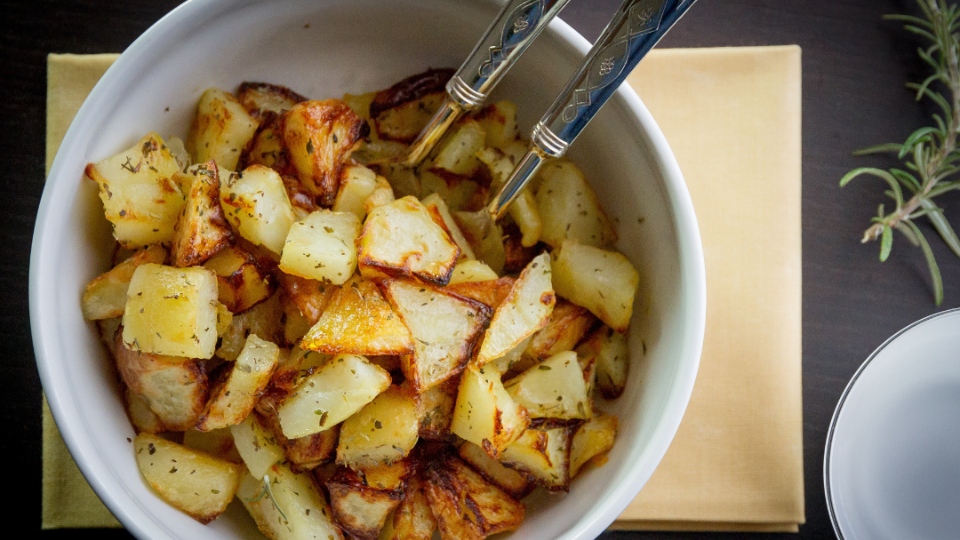Fruit and Vegetable Guide Series: Potatoes

Utah Local Fresh Season: Potatoes are harvested in Utah during the early fall, usually mid-September through October.
Availability: Potatoes are available year-round in grocery stores.
 Eating: It is recommended that potatoes be eaten cooked, as they are very bitter raw. There is a toxin called solanine that is concentrated in raw, highly green potatoes with a lot of buds. Avoid eating them raw. Maximum nutrition is preserved when cooked and eaten with the skin on.
Eating: It is recommended that potatoes be eaten cooked, as they are very bitter raw. There is a toxin called solanine that is concentrated in raw, highly green potatoes with a lot of buds. Avoid eating them raw. Maximum nutrition is preserved when cooked and eaten with the skin on.
Selecting: Potatoes can be found in the fresh, frozen, and canned aisles of grocery stores. When selecting fresh potatoes, select smooth, firm potatoes free of soft or green spots. The varieties include white, yellow, purple and red. Each variety may have a slightly different flavor or texture but can be used interchangeably.
Cleaning and Preparing: When ready to use, scrub potatoes with a vegetable brush and rinse. Rinse just before cooking because rinsing potatoes a long time before use will shorten their shelf life.
Storing: Potatoes can be stored up to 2 to 3 months in a dark, cold (40-55ºF) place that allows air circulation. Good air circulation will reduce rotting and sprouting. If stored at room temperature, potatoes should be used within 1 to 2 weeks. Perforated plastic bags or paper bags help extend shelf life. Do not store potatoes in a refrigerator, or the starch will turn sweet and cause the potatoes to darken while cooking. Do not store potatoes with apples or pears, as the ethylene fruit produces will cause them to sprout. If frozen, potatoes can be stored for 10 to 12 months.
Cooking: There are endless possibilities when it comes to preparing and eating potatoes. They can be roasted, baked, boiled, sautéed, grilled, mashed, turned into soup, made into salads, and the list goes on and on. To enhance nutrition benefits, include the skins.
Potatoes can be prepared up to 1 day before cooking. To prevent oxidation (turning brown) place cut pieces in a large bowl of water with a little lemon juice or vinegar until ready to cook.
Nutrition: Potatoes are a great source of potassium, vitamin C, vitamin B6, fiber, protein, and they are fat free. Potassium helps reduce risk of stroke and hypertension. Vitamin C helps maintain healthy gums and helps to heal wounds. Vitamin B6 helps with energy metabolism. Dietary fiber has many benefits, including regulating blood glucose levels and satiety, or feeling full for a longer time. One potato is about 110 calories making them one of the most energy-packed vegetables.
 Growing: When selecting varieties to grow, consider the growing environment, primary use, and how much space is available to grow the plants. Most varieties grow well in Utah, but not all varieties are available. Most garden centers and nurseries carry varieties that produce high quality, productive seed tubers adapted to local conditions.
Growing: When selecting varieties to grow, consider the growing environment, primary use, and how much space is available to grow the plants. Most varieties grow well in Utah, but not all varieties are available. Most garden centers and nurseries carry varieties that produce high quality, productive seed tubers adapted to local conditions.
Preservation: Potatoes can be preserved in jars. Select small to medium-size mature potatoes of ideal quality for cooking. Choose potatoes 1 to 2 inches in diameter if they are to be packed whole.
Procedure: Wash and peel potatoes. Place in an ascorbic acid solution to prevent darkening. If desired, cut into 1/2-inch cubes. Drain. Cook 2 minutes in boiling water and drain again. For whole potatoes, boil 10 minutes and drain. Add 1 teaspoon of salt per quart to the jar, if desired. Fill hot jars with hot potatoes and fresh hot water, leaving 1- inch headspace. Remove air bubbles and adjust headspace if needed. Wipe rims of jars with a dampened clean paper towel. Adjust lids and process in a pressure canner at 15* pounds of pressure for 35 minutes for pint jars and 40 minutes for quart jars.
References
- https://extension.usu.edu/yardandgarden/research/potatoes-in-the-garden
- https://www.stilltasty.com/fooditems/index/18082
- https://www.potatogoodness.com/nutrition/
- https://nchfp.uga.edu/how/can_04/potato_white.html
Authors
Melanie D. Jewkes, Extension Assistant Professor
Guide Editors: Heidi LeBlanc and Debra Christofferson
Additional Editors: Marie Stosich, Gayla Johnson, Eileen Milligan, Maren Stirling
*This publication is a part of a series created by Create Better Health and Utah State Extension Employees. It has been reviewed and updated to include current evidence-based research and recommendations.
Related Nutrition Articles






